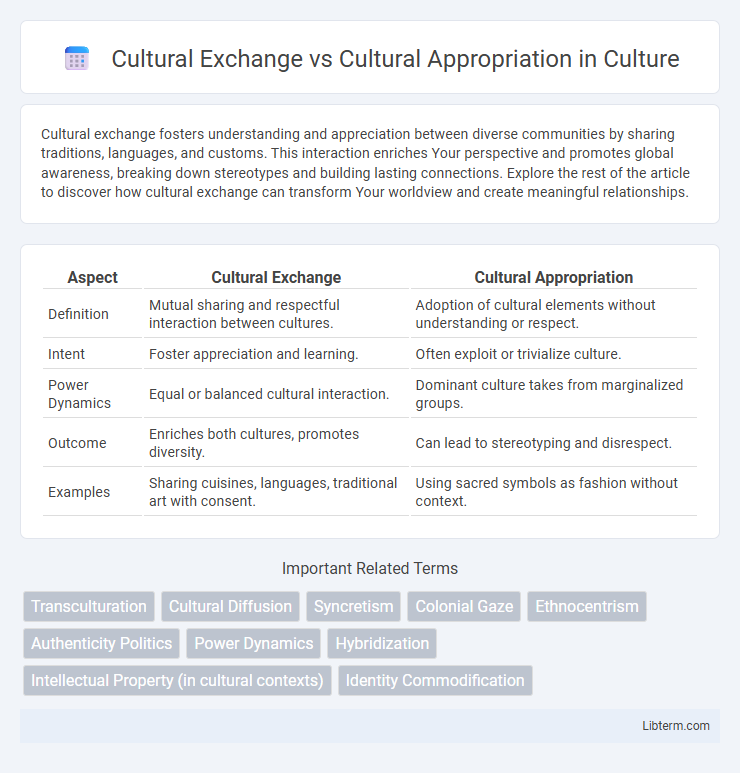Cultural exchange fosters understanding and appreciation between diverse communities by sharing traditions, languages, and customs. This interaction enriches Your perspective and promotes global awareness, breaking down stereotypes and building lasting connections. Explore the rest of the article to discover how cultural exchange can transform Your worldview and create meaningful relationships.
Table of Comparison
| Aspect | Cultural Exchange | Cultural Appropriation |
|---|---|---|
| Definition | Mutual sharing and respectful interaction between cultures. | Adoption of cultural elements without understanding or respect. |
| Intent | Foster appreciation and learning. | Often exploit or trivialize culture. |
| Power Dynamics | Equal or balanced cultural interaction. | Dominant culture takes from marginalized groups. |
| Outcome | Enriches both cultures, promotes diversity. | Can lead to stereotyping and disrespect. |
| Examples | Sharing cuisines, languages, traditional art with consent. | Using sacred symbols as fashion without context. |
Understanding Cultural Exchange: Definition and Importance
Cultural exchange involves the respectful sharing and appreciation of cultural practices, traditions, and ideas between different communities, fostering mutual understanding and collaboration. It promotes diversity and enriches societies by encouraging open dialogue and learning without exploiting or disrespecting the source culture. Recognizing the boundaries between genuine exchange and cultural appropriation is crucial to maintaining ethical and meaningful interactions across cultures.
What Is Cultural Appropriation? Key Characteristics
Cultural appropriation involves adopting elements of a culture without permission, often by a dominant group taking from marginalized communities, leading to misrepresentation and disrespect. Key characteristics include lack of understanding or acknowledgment of the origins, commercialization without benefit to the source culture, and reinforcing stereotypes or power imbalances. This contrasts with cultural exchange, which is based on mutual respect, consent, and equitable sharing of cultural practices.
The Historical Context of Cultural Interactions
Historical context reveals that cultural exchange involves mutual sharing and respect between societies, fostering understanding and innovation over centuries. In contrast, cultural appropriation often stems from power imbalances and colonial histories where dominant cultures exploit marginalized groups' traditions without permission or acknowledgment. Recognizing these dynamics is crucial to appreciating authentic cultural interactions and preventing harmful misrepresentations.
Positive Impacts of Cultural Exchange on Society
Cultural exchange fosters mutual understanding and respect by allowing individuals to experience and appreciate diverse traditions, languages, and art forms, which strengthens social cohesion and global connections. Exposure to different cultures promotes creativity, innovation, and empathy, driving positive social change and collaboration across communities. Educational programs and international events that facilitate cultural exchange contribute to breaking down stereotypes and reducing prejudice, enhancing social harmony and inclusivity.
Power Dynamics in Cultural Appropriation
Cultural appropriation involves the adoption of elements from a marginalized culture by a dominant group, often reinforcing existing power imbalances and perpetuating stereotypes. The unequal power dynamics allow the dominant culture to exploit and commodify cultural symbols without understanding or respecting their significance. This exploitation contrasts sharply with cultural exchange, which is characterized by mutual respect, consent, and equitable sharing of cultural knowledge.
Real-Life Examples: Cultural Exchange vs Appropriation
Cultural exchange involves mutual sharing and respect between cultures, such as the global popularity of Japanese sushi prepared by chefs worldwide who honor its traditions. Cultural appropriation occurs when elements like Native American headdresses are worn as fashion statements without understanding or respecting their significance. These examples highlight the importance of intent and context in distinguishing respectful exchange from exploitative appropriation.
Recognizing Respectful Participation in Other Cultures
Recognizing respectful participation in other cultures involves understanding the difference between cultural exchange and cultural appropriation by valuing authentic engagement and consent from cultural insiders. Cultural exchange promotes mutual respect and learning, where traditions and practices are shared with acknowledgment of their origins, while cultural appropriation involves taking elements out of context without permission, often leading to misrepresentation or harm. Emphasizing respectful participation requires awareness of power dynamics, historical context, and ongoing dialogue to support genuine cultural appreciation.
The Role of Media in Shaping Perceptions
Media platforms significantly influence public understanding of cultural exchange and cultural appropriation by framing narratives that either promote respectful sharing or perpetuate stereotypes. News outlets, social media, and entertainment channels play a critical role in educating audiences about the boundaries between appreciation and exploitation. Representative and diverse media coverage fosters awareness, encouraging responsible cultural interactions and reducing instances of cultural insensitivity.
Navigating the Fine Line: Avoiding Appropriation
Navigating the fine line between cultural exchange and cultural appropriation requires respect for the origins and significance of cultural symbols, practices, and traditions. Engaging authentically involves seeking permission, prioritizing education, and acknowledging the cultural context to avoid exploitation or misrepresentation. Emphasizing empathy and active listening fosters meaningful interactions that honor cultural diversity without perpetuating stereotypes or harm.
Promoting Inclusive and Ethical Cultural Engagement
Promoting inclusive and ethical cultural engagement requires understanding the key differences between cultural exchange and cultural appropriation, where cultural exchange involves mutual respect, appreciation, and shared learning without exploiting or commodifying traditions. Ethical cultural engagement prioritizes consent, context, and acknowledgment of the origin communities, ensuring that cultural elements are represented authentically and respectfully. Fostering dialogue and education helps create environments where diverse cultural expressions are celebrated, protected, and preserved.
Cultural Exchange Infographic

 libterm.com
libterm.com